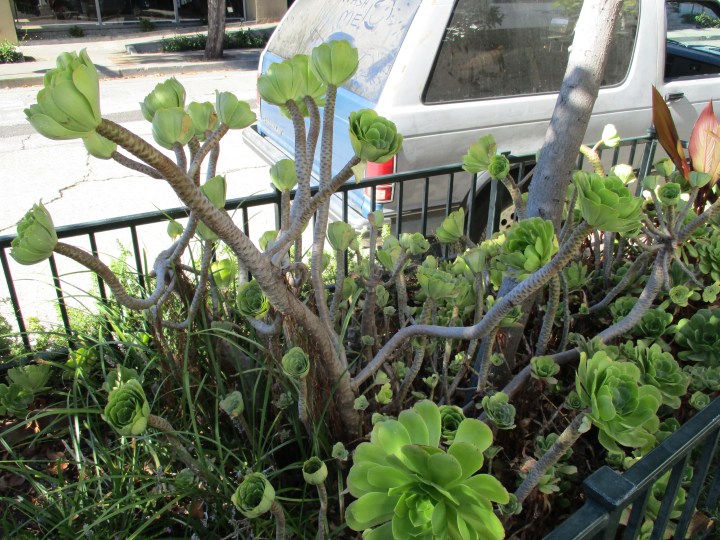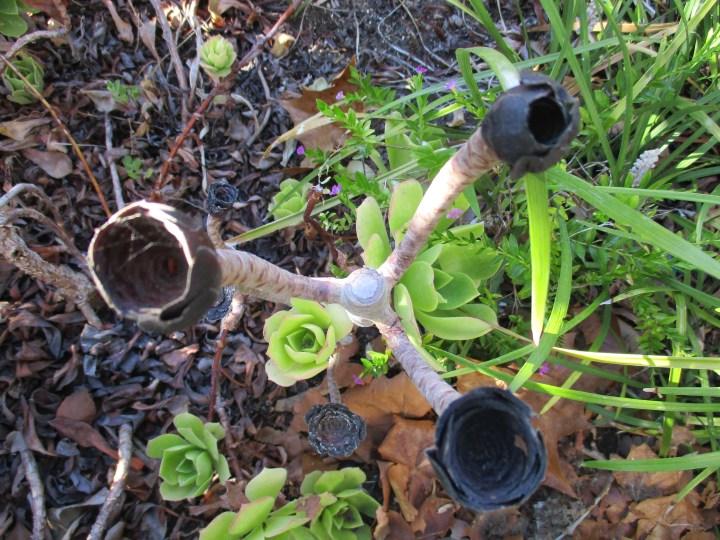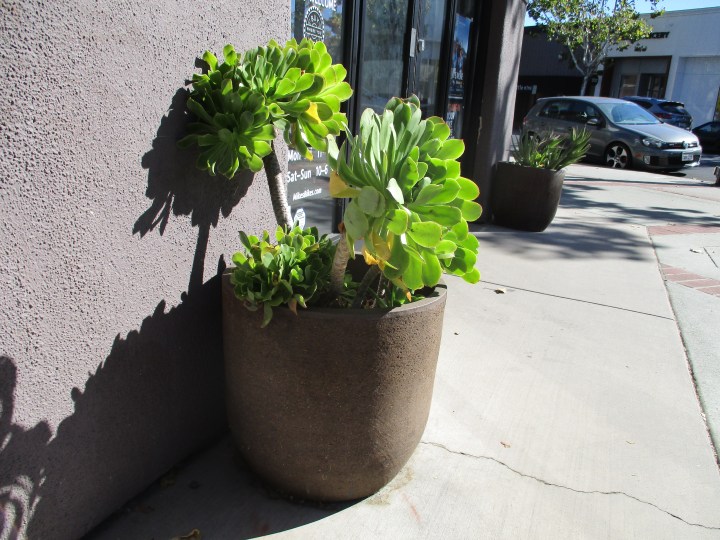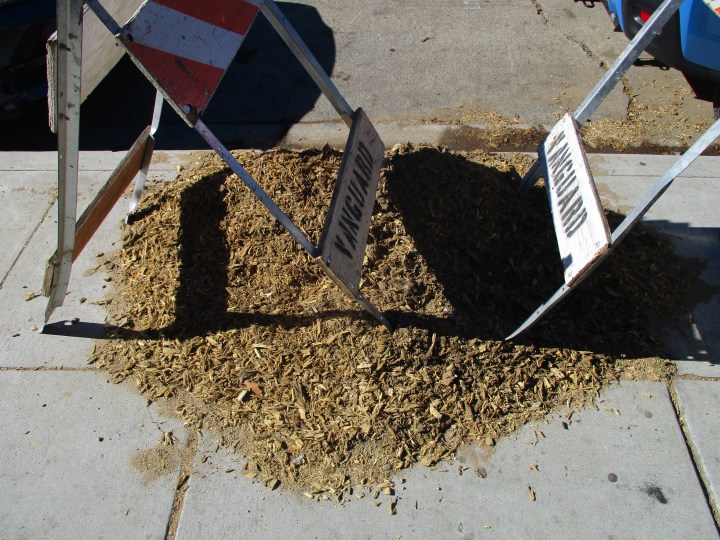It sounds more compelling that way, like the old song by Art of Noise in 1984. It was . . . unique for the time. I suppose it still it. Brent introduced me to that Beat Box when we lived in the dorms at Cal Poly in 1986. Otherwise, to me, the name would have suggested a shallow wooden box for storing root vegetables in a cellar, or a crisper drawer of a refrigerator – a box for beets.
Well, I am just beeting around the bush to avoid sharing the unsightly pictures of my beat-up and neglected planter box downtown, which, incidentally, features neither beets, nor bushes.
The last update was only six weeks ago. https://tonytomeo.com/2018/08/18/six-on-saturday-out-with-the-old/ There has not been much improvement. I manage to remove the litter that accumulates. The condition of most of the plants is unfortunately natural for this time of year. It will not last long. For now, it is what I have to share.
The main problem now is that the common houseleeks, which are the most prominent perennials, naturally looks very tired. I would have no problem with it in my own garden. I know that they look great for most of the year. They look like they do now only in late summer. They recover immediately as soon as the rain starts in autumn. I do not know what is so great about rain, or what rain does that the irrigation does not do. I think that it coincides with cool humidity. Warm aridity is probably what causes the houseleeks to fold up and shed much of their foliage the way they do.
1. Common houseleek was grown from two tiny cuttings that I acquired from the garden of a friend’s deceased mother as we were emptying her home in Monterey. They arrived with a bronze common houseleek, another unidentified houseleek, an unidentified aloe, and, of all things, a bearded iris. They grew like weeds, and are now the most prominent features in the planter box. They would not have been my first choice, but once they started to grow, everyone liked them. I sometimes consider cutting them back so that they regenerate as lower foliar plants; but most people like their height and sculptural stems. I will instead groom out some of the superfluous grown to display their stems better. Once the rain starts, and they regenerate new foliage, they will look exquisite! For now, they look like . . . this.
2. Bronze common houseleek was planted between the two common houseleeks, and at the same time, but never gets going well. As soon as it tries to grow, someone takes the top off of it. It would be an excellent contrast if it gets the chance. It really looks bad right now, but like the others, it will fluff out with the rain. The third smaller houseleek is right below it.
3. One never knows what might be found in a roadside planter box or landscape. Besides the concrete slurry (that was dumped by a tile-setter working in the adjacent building) and big puddles of vomit (such as those commonly found outside of downtown bars), I have found discarded bicycle parts (that were replaced by the adjacent bicycle store), baggies of dog poop, loaded diapers, small bags of trash, and a variety of dishes, glasses and flatware from neighboring restaurants. This disfigured fender is certainly not the strangest item to appear in my planter box, but is one of the largest.
4. Two nice urns outside of the adjacent bicycle shop always look so much better than my planter box. They are filled with nice potting soil, and get watered more generously. The big houseleek in the closer of the two urns was removed from my planter box when it got too crowded. I would have planted a matching pair, but the farther of the two urns had been temporarily removed to make room for a sign. Now that it has returned, it is outfitted with a big aloe from the planter box. The aloe was cut back when the tile on the corner of the planter box where the aloe is located was repaired. I was not there when it happened, but I am very pleased that someone in the bicycle store salvaged the severed bits of aloe. I would have been annoyed if they had been wasted. They are quite large now. It would be excellent if they bloom soon. Most aloes bloom in summer, but this species has tried to bloom at really odd times . . . except in summer! The floral stalks in the planter box have always gotten broken off before they bloom, so I do not even know what the flowers look like. If they never get the chance to bloom, the foliage still looks great.
5. The adjacent tree well really did not look this bad after I pulled up some of the debris that collected in it a month or so ago. It now looks as nasty as it did during my previous update. I know the bit of housleek looks really nasty, but it stays because I expect it to recover once the rain resumes. Nasturtiums grow here too. I will sow seed for ‘Jewels Mix’ nasturtiums in the planter box only because nasturtiums do not regenerate there as reliably.
6. This second tree well that is just west of that in the #5 picture above had a nice magnolia tree in it a month ago. Only this pile of chipped stump remains. The sidewalk, curb and road pavement will be replaced soon. Street trees will be added later. The magnolias were so pretty, but were too impractical and messy. I am impressed that they did not do more damage than they did during the half century that they were there.
This is the link for Six on Saturday, for anyone else who would like to participate:
https://thepropagatorblog.wordpress.com/2017/09/18/six-on-saturday-a-participant-guide/
It was going so well until you mentioned the “big puddles of vomit” . . .
LikeLiked by 1 person
Oh, I am sorry about that. There happens to be a picture of . . . oh, never mind.
LikeLike
Fascinating and all too familiar. I like your tales of street damage and tough plants. You gotta be tough to survive them mean streets. Your house leeks are much more etoliated than those I know.
LikeLiked by 1 person
They are actually not so etiolated as they are bare. The defoliate like that annually, leaving only the top of each rosette. Once they foliate again, not much of the stems will be visible. They are quite exposed there.
LikeLiked by 1 person
Are your common house leeks what I think of as rather exotic aeoniums? A street planter near us has a polite notice asking people not to pee in it!
LikeLiked by 1 person
A sign typically indicates that there was a need for the sign. I mean that if there is a sign regarding it, then it must have happened. ew! The common houseleek is the most common specie of large aeoniums. I refer to the bronze cultivar as the bronze common houseleek, but it is probably not really know as ‘common’ since it is an old bronze cultivar. I believe that it looks something like ‘Zwartkop’, but is not quite as compact. It develops lanky stems like those of the common houseleeks while it is mostly defoliate. While the common housleeks fill in once the rain starts, the bronze houseleek does not fill in quite as well, leaving bare stems visible. Anyway, the houseleeks are aeoniums.
LikeLiked by 1 person
I think I would be quite perturbed to find someone had thrown up in my planter. Does it count as organic matter? Eeewwww.
LikeLiked by 1 person
It is actually worse when it is next to the planter box, and someone in the bicycle store must wash it into the gutter. It is easier to cover with leaves or nasturtiums if it is within the planter box. However, there was once a puddle that was of such thick consistency that it was more like a pile than a puddle, and it was huge! I was pleased that it was on the sidewalk where it was scooped up in a dust pan instead of in the planter box. It was SO epic that I got a picture of it. Would you like to see it?
LikeLike
No thanks!
LikeLiked by 1 person
I’m still amazed whenever you detail the massive littering in your street box. Such a different mentality. Any idea why someone keeps snapping off the bronze leek? Eerily selective of them.
LikeLiked by 1 person
I think that the bronze houseleek is being taken to be rooted in someone’s garden. I thought about walking around the neighborhood to see if I find it in someone’s garden. It annoys me because the poor little plant never gets a chance to grow before it gets broken off again. Large pieces get taken from the common houseleek. I would not mind if pieces were taken from underneath, where they need to be groomed away anyway. It annoys me that whoever takes the pieces breaks them off of the top, leaving big voids and disfiguring the plants. When I need to groom the plants of the superfluous watersprouts, I put the pieces in paper grocery bags and leave them out for anyone who wants them, only to later find more broken off the plants that I just groomed so well! The litter really is interesting. We like to think that we are somehow better than those ‘other’ towns where ‘those’ people live. I work in those other towns, and do not get the impression that people there are as slovenly as we are.
LikeLike
The houseleeks are beautiful: especially those sculptural stems. I’m not sure if I’ve seen them, thought they were something else, or just haven’t paid attention, but they really are lovely. I might just make an inquiry or two out at our really good independent nursery.
LikeLiked by 1 person
They are prettier when well foliated enough to mostly obscure the stems. the sculptural stems are nice, but are overly exposed at the moment. I do not know if I have ever seen the common houseleek in nurseries. Most of us who want them just take pieces from other plants. The only houseleeks I have seen in nurseries are the fancier cultivars.
LikeLiked by 1 person
I think I might remove a planter that served as a receptacle for such nasties. 🤢
LikeLiked by 1 person
If it were up to me, the planters would not be there. I think it makes the historic downtown mall look like a 1970s shopping mall out in the suburbs. However, they are there. They were replaced in the early 1990s. Since they are there, I would rather tend to mine than let someone else do it. So, although I do not like them so much downtown, I do enjoy tending to mine.
LikeLike
I find myself at a loss for words about your post, Tony… ;-). Um, unusual and obscure?
LikeLiked by 1 person
Is that good or bad?
LikeLike